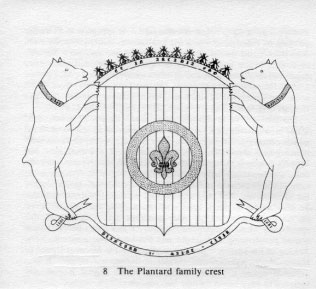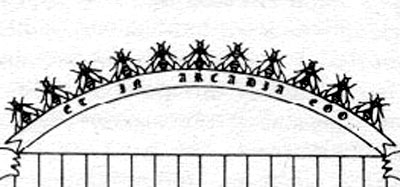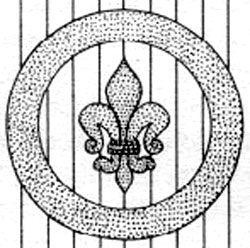|

by Vadge Moore
Oct 24, 2004
from
DragonKeyPress Website
“Our work is therefore historically
authentic; the rediscovery of the Sumerian Tradition.”
- Aleister Crowley
“Lincoln’s researches have undoubtedly illumined certain phases
of an ancient myth-cycle intimately associated with the
Typhonian Current. They reveal a possible connection between an
historic lineage - the Merovingian - and the Typhonian
Tradition.”
- Kenneth Grant
What is this Typhonian Tradition and how
is it linked to the Merovingian/Grail Bloodline and the Priory of Sion as described in
Michael Baigent, Henry Lincoln and Richard
Leigh’s book
The Holy Blood and the Holy Grail?
According to Kenneth
Grant, a leading exponent of this Typhonian Tradition, and head of
the
Ordo Templi Orientis (a magical organization that was once
headed by the one and only Aleister Crowley) this tradition is part
of a current of magical force and occult lore dating back to Sumeria
and pre-Dynastic Egypt.
Originally known as the Draconian
Tradition it is a magical current “based on initiated knowledge or
gnosis of the Fire Snake.” The Fire Snake is also known as the
Kundalini or the Ophidian Current; the basis of all true initiation.
Who is Typhon? According to Mr. Grant, Typhon is,
“The feminine aspect of Set;
sometimes typified as the Mother of Set in her role of Goddess
of the Seven Stars, of which Set is the Eighth.”
Set is the brother of Osiris in the
Egyptian Pantheon. Set, Osiris’ dark brother, chopped Osiris up into
many pieces, leaving him for dead. Set was also the prototype for
Satan. Grant writes,
“The word Set or Sut, means ‘black’.
This indicates not only the generative nature of this god but
also his association with the night-world, Amenta, for from
being a god of the heavens Set fell beneath the horizon and was
recognized in later mythologies as the Lord of Hell, the
Hidden
Land…. This god is of supreme importance in Crowley’s Cult, being
not only the name of the primal creative spirit but also the
formula of sexual magick.”
Set was the “black god”. He was known as
“he who is below.” He was banished to the underworld by his “twin”
Horus for killing Osiris.
The Nephilim were banished to the center
of the earth for disobeying God by mating with the daughters of men
and teaching them the “forbidden” arts. In this publication the
Nephilim have been identified as the Fathers of the Merovingians.
Set was generally considered to be a vile, vicious god baneful to
men. But there are enough aspects of this god that link him to the
ancient Sumerian myths, the basis of the Merovingian mythos
published in this magazine, to show that Set is to be identified
with the same gods and characters that make up these Mythos. He may
have been considered baneful towards some races, but not the race of
the Grail.
In E.A. Wallis Budge’s book The Gods of the Egyptians,
Set is
identified as a personification,
“of the forces of the waters which
were supposed to resist light and order. A number of beasts
which dwelt in the water, were regarded as symbols of him and of
beings wherein he took up his habitation.”
We will recall that the Merovingian race
was sired by a water beast known as the Quinotaur. This Quinotaur
took the form of a sea-bull. Crowley’s personal seal was of a sea
goat. Grant, writing of Crowley’s Seal of the Beast, says:
“The beast is the sea-goat or
amphibious monster identical with
Cthulhu, the Quinotaure or
Bull of the Deep.”
Grant writes as a footnote;
“The waters under the earth; home of
the ‘ancestors’ or subconscious atavisms of the race.”
Is this a reference to the race of the
Grail?
Grant, writing of the cross of the four corners says;
“The intersection of this surface
(horizontal and vertical ) represent, therefore, the gateway to
another dimension, the waters beneath the earth that mirror in
their uncertain depths the heights of space above the earth
wherein glow the stars, the unborn or un-fleshed souls of future
states of consciousness, or simply life beyond earth. The mortal
world spreads east and west and the land of le invisibles lies
above and below it in the vertical dimensions of height and
depths, north and south, Horus and Set.”
This ties in with
The Book of Enoch and
the Hosts above and the fallen, banished Nephilim below. This also
reminds us of the twins or brother gods in
Sumeria called Enki and
Enlil. Enki, the infernal of the two, represents Set and
Enlil
represents Horus (although in this context Enlil would also be
Osiris). In ancient mythologies names and stories can be switched
and one god can also be an attribute of another. It’s best to keep
this in mind when studying this type of material. Set kills Osiris
as Enki kills Enlil. As it has been shown in another article of this
publication, Enki is associated with Cain, and Cain was a very bad
boy. Enki was an infernal god that has been identified, in this
publication, as siring the Merovingian race.
Crowley writes, regarding his Holy Guardian Angel Aiwass, or for
want of a better term, his spirit guide;
“I now incline to believe that
Aiwass is not only the God or Devil once held holy in Sumer, and
mine own Holy Guardian Angel but also a man as I am, insofar as
he uses a human body to make His Magickal link with mankind…”
Aiwass is the “minister” of Hoor-Paar -Kraat
who is another aspect of Set. In Crowley’s
Book of the Law, Aiwass
puts Crowley in touch with the gods now in charge of this planet.
This is significant as Crowley describes
Aiwass as also manifesting as a man not just a god. This is what we
have discovered in this magazine regarding the gods of ancient
Sumeria who appeared as gods, men and kings. They seemed to straddle
the fence of the divine and mortal worlds. Enki has been associated
with Set (in Tracy Twyman’s article
The Merovingian Mythos: Its
Symbolic Significance, and it’s Roots in the Ancient Kingdom of
Atlantis) who is also Satan. It is significant that
Crowley
identified himself as, “The Great Beast 666.”
In one of Grant’s glossaries we read:
“Vivo: A corrupt form of OVIZ or
Aiwaz, the god worshipped in ancient Sumer and identical with
Set or Shaitan.”
Grant, writing of the “eye of the void”
of a primal African cult says:
“This void was known as Elemi, a
name which is said to be incommunicable. It was the equivalent
of El or Al, continued in the Draconian Cults as El Shaddai or
Al Shaitan, the stellar deity worshipped by the Arabs and the
Jews and by the earliest settlers in Sumer (in Sumeria the god
El is also known as Ia) Alemi or Alhim became the Elohim of
biblical lore. These gods or cosmic powers poured through the
Veil of the Ain - the all seeing eye - which has its human
analogue in the ajna chakra, concentrated in the first power
zone-Kether.”
The Elohim are messengers from on high
bringing “knowledge” down for mankind, similar to the Nephilim. They
are also associated with Set, or the Chaldean form of Set, Shaitan.
Writing of the Great Old Ones or Elder Gods from Lovecraftian lore,
Grant says,
“The letter M, the key vibration of the plane of the
Elder Gods, is represented mythologically as the sea-goat,
Makaru or
as the crocodile, the beast of the waters.”
Couldn’t Makaru be a
form of Merovee who spawned the Merovingians, and was sired himself
from a sea-bull?
Tracy Twyman has already written of the connections
between Lovecraft’s Necronomicon Mythos and the Merovingians in her
article
Dead But Dreaming: The Great Old Ones of Lovecraftian Legend
Reinterpreted as Sumerian/Atlantean Kings.
Now we come to the Qlippoth. The Qlippoth are denizens of the back
side of the Tree of Life. This back side or dark side is said to be
behind the regular Sephirah of the Qabalah. They are said to be the
shells or the husks of the dayside of the Tree. But according to
Kenneth Grant they are actually the first, primal manifestation of
all things. In terms of Lovcraftian lore they are the Ancient Ones
or Great Old Ones of
the Necronomicon. They are the first primal
void of Nothing before there was something.
They have been considered evil by
Qabalists and Occultists for centuries only because they represent
the terrible blackness of the void and the complete destruction of
what we understand as ego, which seems horrific to us. These
Qlippoth reside in what is known as the Tunnels of Set. These
Tunnels are behind or beneath the Day Side of the Tree of Life as
the Nephilim reside beneath the earth. As terrifying as these
“beings” may seem, Grant says they are here to enlighten us, as
the
Nephilim were. Why is the abode of these beings called the Tunnels
of Set?
Grant writes:
“Of Set, because Set is the Seat of
the powers manifest as the Tree of Life.”
This is what is known as the Typhonian
Tradition that Kenneth Grant speaks of.
Let’s review: Kenneth Grant believes that he is a part of the
Typhonian Tradition or Draconian Tradition which is concerned with
the god Set who, like the Nephilim, was banished to live beneath the
earth. The Nephilim are believed to have sired the Merovingian Race.
Set is a god of the waters and the Merovingian race was sired by a
god, the Quinotaur, that also was a beast of the waters. The
denizens of the Tunnels of Set, which are behind the Tree of Life,
or beneath have been considered “evil” and bestial and are known in
the ancient Hebrew texts of the Qabalah as the Qlippoth. The
Qliphoth, according to Grant, are actually of benefit to the
initiated in order to take them to another level of initiation. Now
here is the kicker: according to E.A. Wallis Budge,
“Animals with red or reddish brown
hair or skins were, and even red haired men were supposed to be
especially under the influence of Set.”
As is well known to anyone reading this
publication, the Merovingians were notorious for their red hair and
it was believed that this is where they received all of their
“powers.”
Crowley’s design of the Chariot card in his Tarot Deck depicts a
Knight (Templar?) holding a disk that represents the Grail. Anyone
having read The Holy Blood and the Holy Grail would know that the Templars were Knights pledged to defend the
Merovingian/Grail
Bloodline. Grant says, in a footnote;
“it should be noted that the Graal-Bearer
[represented on the Tarot card] is depicted in amber-coloured
armor [amber or red, the color associated with the Merovingians].
Amber or Orange appears repeatedly in accounts of UFO
sightings.”
Crowley, in his
Book of Thoth, writes;
“The Charioteer is clothed in the
amber-coloured armor appropriate to the sign. He is throned in
the chariot rather than conducting it, because the whole system
of progression is perfectly balanced. His only function is to
bear the Holy Grail.”
Grant writes,
“The bearer of the Graal [Knight
Templar?] depicted on Atu VII [the Tarot card] may therefore be
identified with the bringer to earth of the Sangraal, or
blood
royal, the blood which flows in the veins of the Kingly Man
extolled by Crowley, although not understood by him in the sense
of trans-human Intelligence. Crowley’s design for the Graal
resembles as closely as may be, for a pre-1947 representation, a
shape frequently described in connection with particular types
of UFO.”
Pre-1947 because, as Grant says, that
year was the modern explosion of accounts of UFO “sightings” around
the world. I am not partial to the literal belief in UFO’s. I
believe, as Dr. Carl Jung believed, that these UFO sightings are a
product of our unconscious veiling of an ancient human experience.
Enough said. This “bringing to earth” of the Sangraal by UFO’s is
the modern day equivalent of the Nephilim, the Outer Ones, or the Elohim earthling “knowledge” and siring a new race of “kingly”
beings for this world. Kingly i.e., the Merovingians. The
Merovingian blood is the blood of kings, the kings or gods from
ancient Sumeria and beyond.
In his book Outer Gateways Kenneth Grant writes:
“In The Holy Blood and The Holy
Grail, the authors reproduce the family crest of Clan Plantard,
the contemporary representative of which was, until recently,
the Grand Master of the Prieure de Sion, an Order which,
according to Lincoln, dominated the Order of the Knights Templar
and various other highly influential institutions which, at
certain periods of history, included
the Vatican. The crest
which supplies the key to the Current represented by the
Merovingian bloodline and the Order of Sion, comprises the
symbols of the Typhonian line of descent: the two bears,
eleven
bees, and the fleur de lys.


The motto incorporated in the crest
reads Et in Arcadia ego (above
image). Arcadia=127, which is the number of the
Egyptian Goddess Heqt who was typified by the ‘lower part of the
back, or haunch.’ The two bears denote the Mother (Typhon) and
her son (Set). The image of the bee pictorializes the buzzing or
humming vibration peculiar to the Outer Ones, or their vehicles.
Eleven is the number of Those who are Without, or beyond, the
Tree of Life, thus identifying the Outer Ones.”
The Outer Ones are also the Qlippoth or
the Ancient Ones of Lovecraftian lore. That the Typhonian Tradition
and the Merovingian Tradition share the same important symbols seems
to be much more then a mere coincidence.
In the Typhonian Tradition the Bear is the constellation of
Ursa
Major. The stars must be aligned in a specific way in order for Set
to be properly invoked. To the Priory of Sion (the secret, occult
organization dedicated to preserving the Merovingian Bloodline), the
Bear was an animal of the Goddess Diana. According to Lynn Picknett
and Clive Prince, the authors of
The Templar Revelation,
“ …the Merovingian kings, from their
founder Merovee to Clovis (who converted to Christianity in 496)
were ‘pagan kings of the cult of Diana’.”
Picknett and Prince got this information
from the Dossiers Secrets of the Priory of Sion. The bees, which are
a recurring symbol of the Merovingians are, in the Typhonian
Tradition, represented frequently as the humming or buzzing sound
that occurs before the appearance of the Great Old Ones or “beings”
proper to this tradition. Grant writes
“The bee, beetle, or crab, is
therefore the link between the earliest manifestation of the
Typhonion current and its final phases.”
Also:
“217 is the key number of
[Crowley’s] The Book of the Law. 217 is also the number of
DBVRH,
meaning ‘a bee’ which is the specific symbol of Sekhet, whose
name means ‘a bee.’ Sekhet is another aspect of the god Set.
There are eleven bees because eleven is the number of Magick and
of the sephirah on the Tree of Life, called Daath, which is the
“Gateway” to the backside of the Tree and to the Gods.
Kenneth Grant’s wife Steffi Grant
illustrated the cover of her husband’s book Beyond the Mauve Zone
with an image of two bees holding a crystal.

As for the fleur de lys,
in the Typhonian Tradition it represents the ‘kingly man’ that
Crowley extols and the inheritor of the Grail Bloodline. In
The
Vision and the Voice, Crowley is “conversing” with his Holy Guardian
Angel Aiwass, who says:
“For I am not appointed to guard
thee, but we are of the blood royal, the guardians of the
Treasure-house of Wisdom”: the “blood royal,” the Sangraal of
the Holy Grail.
Throughout all of Kenneth Grant’s books
there are references to ideas, archetypes, and images related to
the
Sumerians, the Merovingians and especially to the mythos that
Tracy Twyman has been uncovering in this publication. There are references
that I haven’t even mentioned. For instance, the bat wings
discovered at Rennes le Chateau that in the Typhonian Tradition
represent the inversion of the senses that lead to enlightenment and
occult knowledge. I agree with Grant that Henry Lincoln’s research
has,
“illumined certain phases of an
ancient myth-cycle intimately associated with the Typhonian
Current.”
It seems that the farther down this road
we go, the closer we get to the truth.
|



